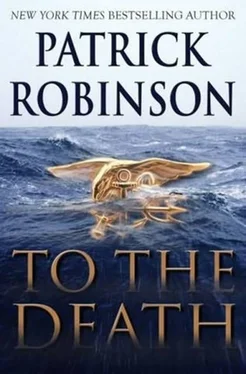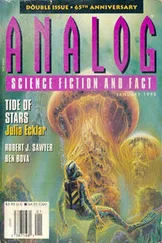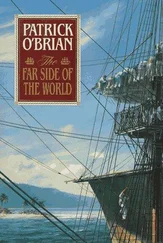This is where the design refinements for the 240-foot-long underwater boat were perfected. The RUBIN scientists have worked for years trying to make the Kilo as quiet as the grave, every engine mounting, every working part, every vibration considered, improved, and eventually silenced. Running deep, Hull 901 would make no more noise than a modern computer.
All three thousand tons of her, superbly streamlined, can slip through the depths at six knots, betraying virtually nothing. She cuts her speed below five, she’s vanished. Of all the underwater warriors, the Kilo is one of the most stealthy, partly because, unlike a big nuclear boat, she has no nuclear reactor requiring the support of God knows how many subsystems, all of them noisemakers.
There is but one flaw in this masterpiece of Russian design. And that happens when she needs to recharge the huge batteries that power her electric motors. The Kilo is vulnerable when snorkeling, because her generators are merely two big diesel internal-combustion engines, which, like a car, must have air.
And that requirement sends the submarine to periscope depth, where those generators can be heard, the air-intake mast can be picked up on radar, and the ions in the diesel exhaust can be “sniffed.” If she’s not careful, she can even be seen, and there is absolutely nothing she can do about it.
The Kilo-class submarine, moving swiftly, must snorkel and recharge her batteries every two hundred miles. Through the Mediterranean Sea, from one end to the other, she needs to complete this process twelve times before exiting into the Atlantic.
Of course, the U.S. Navy’s detection systems are extremely advanced and the mighty Los Angeles-class nuclear boats are certainly a match for the covert Russian submarine. The chances of a Kilo getting close enough to hit an American ship are remote, just as long as no one takes their eye off the ball.
Nonetheless, the retired American admiral residing in Chevy Chase, Maryland, continued to believe Iran’s Mediterranean submarine should be hit and sunk forthwith. President Bedford was inclined to agree, particularly since it was possible for a big U.S. nuclear boat to get rid of any foreign submarine and never be located.
In subsurface warfare, it has been ever thus. Because, contrary to popular perception, submarines cannot communicate with home base while they are underwater. Their only form of communication is via satellite, and for that they must have a mast, briefly, jutting above the surface.
Thus, all submarines have a daily call time, when they come to periscope depth, usually in the dead of night, and announce their course, speed, and position in a minisecond electronic burst to the satellite circling twenty-two thousand miles above the Earth. They then ask if there are any messages, scoop them up, and return immediately to the ocean depths. If the entire process takes more than fifteen seconds, then someone’s been grotesquely inefficient.
The progression from this myriad of Naval Intelligence leads to one stark truth-if a submarine hits another with a torpedo, no one knows it’s happened. The stricken ship will sink to the floor of the ocean, sometimes without a trace. The first clue to its disappearance will be a missed call home via the satellite. And this might very easily be twenty hours after the hit.
And one missed call is not usually a five-alarmer, because the problem could have been electronic, or maybe even carelessness. Certainly one single missed call-in does not signify the ultimate horror of a submarine lost with all hands. And so to the second missed call, the following night. What does this mean? And what to do?
It might be forty-four hours since the submarine was sunk. And an enemy could very easily have been traveling at twenty knots, speeding away from the scene of the crime. That’s 880 nautical miles! In any direction!
Which leaves some hapless home base with a search area of thousands and thousands of square miles in waters perhaps one or two miles deep. Chances of crew survival: zero. Chances of location: close to zero. Situation: hopeless. What to do: probably nothing.
The victim’s navy will most certainly not admit what might have happened. The perpetrator will, naturally, not know what anyone is talking about. And the entire incident may never be disclosed. By anyone. Has it ever happened? Of course. But the oceans guard their secrets darkly. Who knows how many iron coffins rest in the weird, lost canyons of the seven seas? All it takes is one well-aimed torpedo, with a big warhead, and no one will be any the wiser.
Which was why Admiral Arnold Morgan had, on several occasions, advised President Bedford to hit that Iranian Kilo-class submarine-before the sonofabitch hits us or the Israelis. The submarine to which he referred was, of course, the very one that now carried General Rashood, commander in chief of Hamas, on his mission to assassinate Admiral Morgan himself-a poetic malevolence worthy of the Devil.
At 0400 on this Saturday morning, General Rashood was in the navigation area, talking to the young officer who was plotting the course of Hull No. 901, Lt. Rudi Alaam, a career officer from the eastern Iranian province of Kerman. Both men were leaning over a circular computerized chart that highlighted the central part of the Mediterranean.
It showed the submarine, which was running hard, snorkeling at periscope depth, moving west through the channel north of the island of Malta and its tiny offspring Gozo, both of which lie in the broad waters that separate Sicily and Tunisia. The Med goes shallower through here, and it was the first time the navigation officer had had to attend to the depth of the water.
Almost immediately, running west away from the coast of Lebanon, the Kilo had run into vast ocean depths, nine thousand feet, lonely waters, the Greek island of Rhodes 240 miles off their starboard beam. The GPS read 34.00 North, 22.30 East when they were southwest of Crete.
Right here, 120 miles off the coast of Libya, the ocean floor shelved down even deeper, another three thousand feet. They passed well south of Sicily’s Cape Passero with more than two miles of blue water under the keel. A land soldier rather than a sailor, General Rashood found the whole exercise somewhat creepy.
So far, they had not encountered any U.S. or Royal Navy warships. But headed for the narrow waterway where the tip of Italy’s boot looks likely to kick Sicily straight into Tunis Harbor, the submarine needed to exercise inordinate care. This was an ancient throughway for the Royal Navy. The ocean was much shallower, less than two hundred feet in places, and the carrier battle groups of the U.S. Navy tended to treat the place like Chesapeake Bay.
Detection was something Captain Mohammed Abad wished to avoid, but not at the expense of his speed. If he thought he was being tracked by a U.S. nuclear boat, he would slow and dive. But he doubted the Americans would actually sink him right here in these busy shallows. He knew that once located by the hugely sophisticated U.S. sonars, they could track him with ease and put him on the bottom of the Atlantic as and when they wished, as soon as he ventured into deep ocean water.
But he had as much right to be here as they did, and, like all Iranian politicians and military leaders, he did not think they would dare.
Captain Abad kept going, transmitting as little as possible. He would sneak past the Sicilian port of Marsala, moving more slowly, and then accelerate through this stone-silent ocean, almost on the surface, in the dead of night, moving forward making course nor-nor-west, as swiftly as possible.
Neither he nor General Rashood realized that up ahead of them, a mere two hundred miles, ran the great, jet-black monster Los Angeles-class submarine USS Cheyenne, her captain already alerted to the possible presence of a rogue Iranian Kilo patrolling in the Med, doubtless up to no good.
Читать дальше












